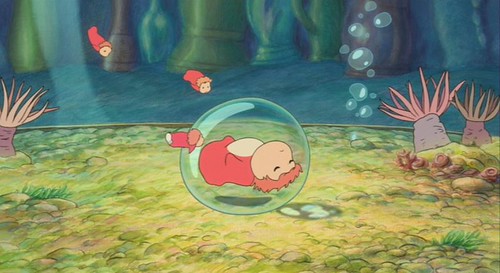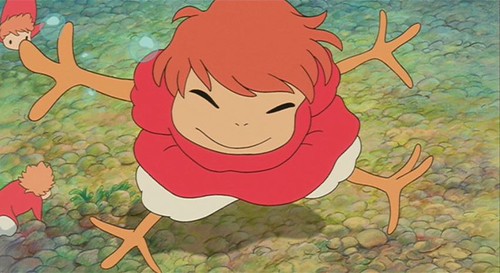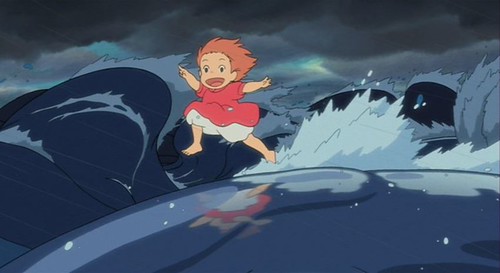From late 2010.I’ve been thinking about Hayao Miyazaki a lot. Here are three notes about his films. There’s a connection between them, but not an argument.
The screen shots are from Ponyo, depicting her in three phases in her being.
The Miyazaki Canon
When we think of Miyazaki, we think of a series of animated feature films started with Nausicaä of the Valley of the Wind. But that’s not his first film; The Castle of Cagliostro is, and Miyazaki also did lots of TV work earlier in his career. Why do we set that work aside when thinking of Miyazaki?
The answer is intuitively obvious when one looks at the pre-Nausicaä work. If you look at Cagliostro, which I know fairly well (but I’ve not seen any of the TV work), it’s obvious that it’s in a different world from Nausicaä and subsequent films. It’s a well-make action-adventure film, as are, for the matter, the later Castle in the Sky or Porco Rosso. But it lacks something that the later films have.
What is it? We can use works like subtlety, richness, or complexity, all of which seem apt. And yet they’re just words. What do they mean? How do we find them in the films?
However we approach those questions, I note that Nausicaä signals its difference from Cagliostro in obvious ways. From the opening frames of the film (see this post at Acephalous), we know we’re in a strange world, a dying post-apocalyptic world. In contrast Cagliostro looks bright and sunny. Both are full of adventure, but Cagliostro is a crime caper while Nausicaä is a save-the-world quest in a post apocalyptic world. The hero of Cagliostro is male, Lupin III, and he saves a princess. Nausicaä’s hero is, of course, Princess Nausicaä herself.
Instability: Man and Nature in Nausicaä
Nausicaä of the Valley of the Wind is widely regarded as an ecological fable, and obviously so. And yet that doesn’t quite get it right. It seems clear that, in a general way, the world is looking bleak for humans, and I emphasis that, for humans, because of a firestorm wrought by humans 1000 years ago. There’s a poisonous jungle that’s growing larger and land suitable for human habitation is shrinking. The war between the Pegites and the Tolmekians is linked to their (mistaken) efforts to deal with this problem. Nausicaä and her people are caught between these two greater powers, whose war threatens them more than the jungle.
Now, consider a passage from interview Miyazaki gave the day after the film opened in 1984 [Hayao Miyazaki. Starting Point: 1979-1996. San Francisco: Viz Media 2009, p. 335]:
— About the depiction of the Sea of Decay: in the early scenes, such as the village where Yupa ends up, it’s rather eerie. At the end, the Sea of Decay where Yupa and Asbel are traveling appears very bright.
Miyazaki: We see birds that harm humans as harmful and those that are useful to humans as useful. It’s all arbitrary. The impression we have of a landscape changes depending on the emotions of the person view the landscape. Nature that is generous is, at the same time, nature that is ferocious. This is why humans feel humbled in the face of nature and why they are able to realize its true abundance. In The Dark Crystal, they talk about the earth’s surface being damaged for thousands of years. And at the end, what happens is that something like a golf course is shown. [laughs] Compared to that, the original jungle, with its multitude of inhabitants, was much livelier. I think that’s fine. So I think it’s a very strange story.
In such a world humans do not have a privileged place. How do you center a movie on humans – and this movie is surely centered on humans – in such a world? What makes their impending extinction a matter of central concern?
a strange girl. She seems to regard the lives of insects and humans in the same way. So, though she couldn’t save Lastelle’s life, she wants to save the baby ohmu . . . To Nausicaä, embracing the baby ohmu and embracing Lastelle are the same thing. [p. 334]
Though herself human, Nausicaä would seem to be a protagonist designed for a world in which humans are not privileged. In the final sequence she is as much concerned about the baby ohmu being used as bait as she is about her people.
Now, as I think about this, I suspect the conception I’ve outlined is a rather rickety one, that it is unstable, that there is no way it can be made fully coherent and consistent. After all, Miyazaki is a human being and his audience consists of human beings. That fact effectively assigns privilege to the humans represented in the movie. Thus, we might think we’ve found Miyazaki in a contradiction.
And perhaps so. But surely Miyazaki-san knows that. Let me suggest that this contradiction, this instability, is a feature, not a bug. And it is that instability that Miyazaki-san’s been exploring ever since.
Thus Nature is not just the setting in which Miyazaki stages this story of political conflict in a time of ecological disaster. Nature is an active force, most obviously in the ohmu. The ohmu protect and avenge the forest (as Obaba explains at one point); they communicate with her through their feelers (informing her that the Pegite pilot has crashed into the forest), and they bring Nausicaä back to life. They shape the outcome of events as much as any human actors.
Miyazaki and Films Suitable for Children
We in America tend to think of animation as children’s fare or, a bit more expansively, as ‘family entertainment.’ The Japanese see things differently. Nausicaä is not fundamentally a children’s film, nor even family entertainment. The same goes for Porco Rosso, Princess Mononoke, and Howl’s Moving Castle. Other films, such as My Neighbor Totoro, Spirited Away, Ponyo and others, are clearly directed at younger audiences.
Why does Miyazaki make those films? Presumably, he does so because he finds them compelling. And why does he find them compelling?
One should, of course, ask him. But let me speculate.
Children are growing, they’re changing, they haven’t yet arrived. In a sense, they’re unstable. That’s the appeal. Miyazaki’s imagination lives in a universe that’s unstable. It’s in flux. A state of becoming.



No comments:
Post a Comment